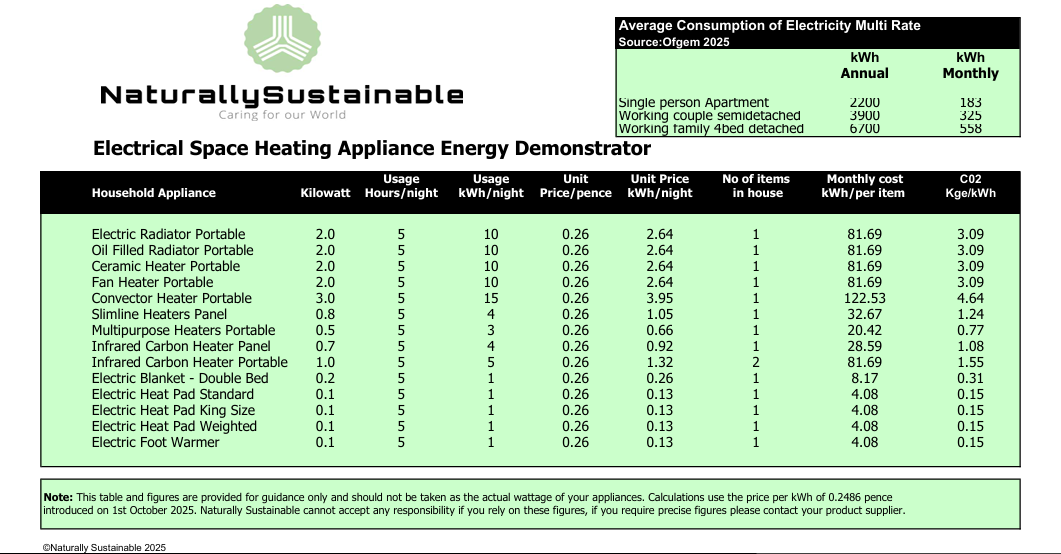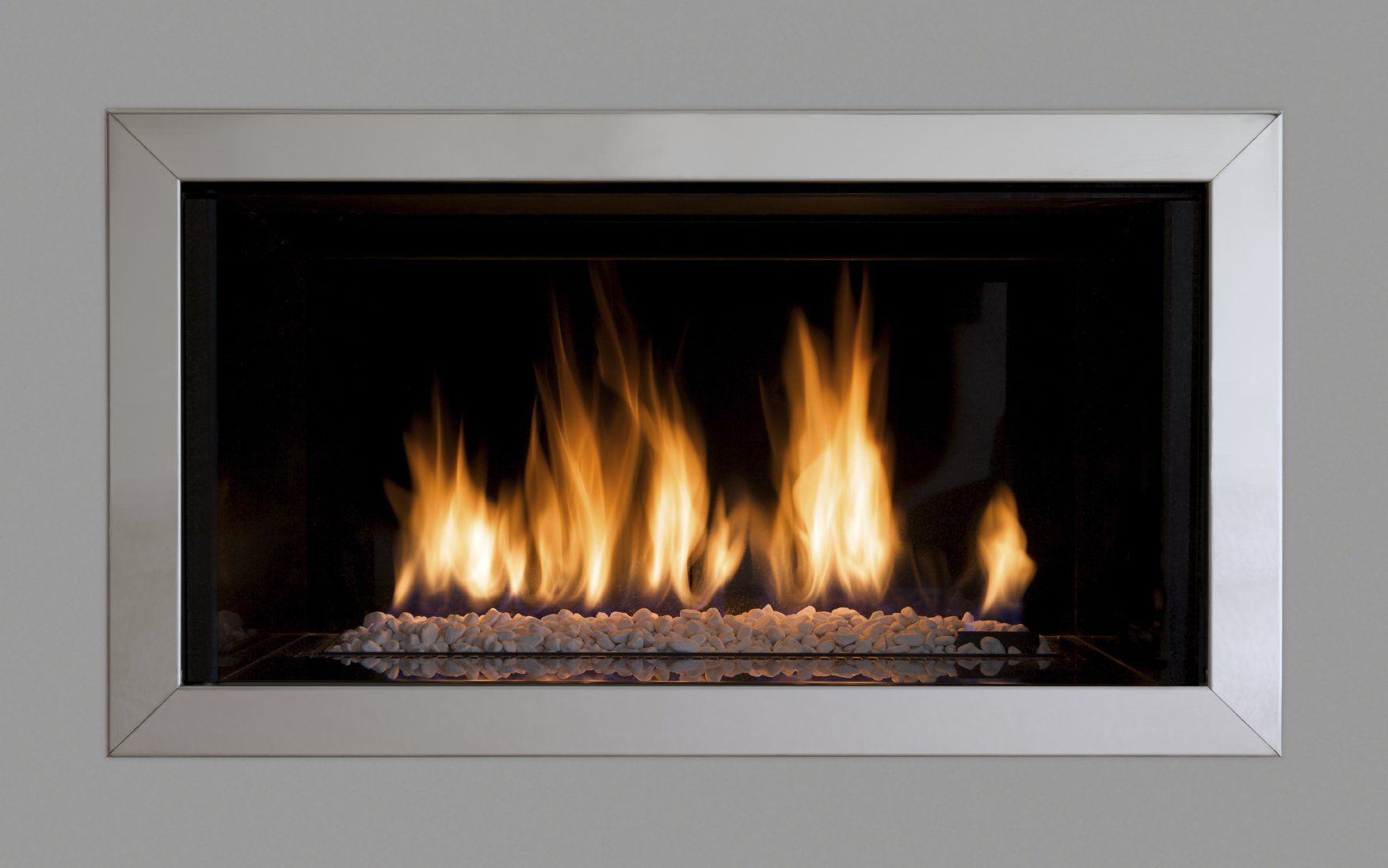Save energy in every room at home
Are space heaters expensive to run? We take a look at the options for portable and fixed electric heaters plus wood burning stoves. We compare them to gas central heating and show by how much they can all hit your pocket.
Some examples of energy consumption around your home:
- single fridge-freezer: expect to use 1 kWh in 26 hours
- electric oven: expect to use 2 kWh for 30 minutes of use
- single tumble dryer: expect to use 4.5 kWh in a single cycle
Gas Central Heating
Wood Stoves
Fixed Heaters
Portable Heaters
In-depth Review of Space Heaters
by Naturally Sustainable
Foreword
Naturally Sustainable is an online resource promoting sustainable activity at home, at work and when travelling. We are completely independent and provide our information free of charge to homeowners and small businesses in the UK. This review does not generate any income it has been prepared using best available information to help homeowners and small businesses decide which space heating options is right for them.
Ofgem report that between 1st October and 31st December 2025 the energy price cap is set at £1755 per year for a typical household which uses gas and electricity throughout the year and pay by Direct Debit. This represents an increase of 2.0% over the previous price cap of £1720 set in July 1st to 30th September 2025.
For a typical user paying by direct debit, the unit rate will be 26.35p/kWh for electricity and 6.29p/kWh for gas. The average daily standing charge will be 53.68 pence per day for electricity and 34.03 pence per day for gas. The energy price cap for homes with prepayment meters is £1707, by Standard Credit £1890 and Economy 7 Direct Debit £1179.
Ofgem review and update the price every three months. The levels over 2025 will be announced as follows:
25th November 2025 - For the period 1st January to 31st March 2025
25th February 2026 - For the period 1st April to 30th June 2026
27th May 2026 - For the period 1st July to 30th September 2026
Further information is available on the OFGEM website here
Gas Central Heating
In excess of threequarters of all homes in the United Kingdom have gas central heating, and, as we head through winter our bills will increase, householders are urged to submit energy readings regularly to ensure they are charged the correct prices. The next price cap review is due on 25th November 2025. The average consumption per year for gas heating of a 2/3 bedroomed house is 11500kWh and for a 4 bedroomed house 17000kWh.
We will be doing all we can to reduce heating costs, but a word of warning, if you do have gas central heating, do not switch it off!
It is not just false economy to turn the boiler off, it is inviting problems with the boiler itself, with cold and damp circulating in hallways, kitchens, bedrooms and dining rooms and worst of all burst pipes from cold snaps. Central heating was designed to protect the house and its occupants from the worst effects of winter. It is important to get your boiler serviced, if it is old get it replaced, some homeowners will benefit from grant assistance. A new combi boiler will make a huge difference to heat around the home and your pocket.
Radiators
Unfortunately, many older homes still have single panel radiators which may not give out the right amount of heat. Nevertheless, even inefficient radiators provide heat around the house.
Experts will advise that radiators between twenty and thirty years old lose efficiency as they age. In a recent survey we found single radiators in the rooms of a detached 1960's house were giving off about 40% less BTU's than considered adequate by today's standards. In the long term the right course of action is to change the radiators for modern convection double units calculated to provide the correct British Thermal Units (BTUs).
Wood Burning Stoves
Many people are switching to wood burning stoves, providing heat over the evening and weekends at a cost of between £2.00 to £3.50 for a six-hour period depending on whether the householder buys split seasoned logs or kiln dried.
If the stove is in use all day costs would vary between £6.00 and £10.50. Remember this is to heat just one room!
The more logs a householder buys the lower the cost. The lowest prices are based on buying at least one cubic metre and up to three cubic metres. Pick up costs for Hardwood kiln dried per cubic metre will average between £120 -£150 per cubic metre. Seasoned hardwood will cost between £80 - £120 per cubic metre. Seasoned softwood averages £50 - £80 per cubic metre. Delivered costs for a 3 cubic metre load mixed logs varies between £200 - £400 and a bulk load of 6 cubic metres kiln dried £600 - £900.
A standard wood burner will consume between 1.5 to 2.0 kilos per hour, over the course of the evening between 6 - 9 kilos.
The most expensive way to heat your home with a wood burner is to buy heat logs from the local store or supermarket. At around £10.99 per 8 kilo bag, the cost over the winter months from October to March amounts to a staggering £2000, working out at around £11.00 per evening.
Wood burning stoves can be integrated into your hot water or central heating system, however the cost of the installation and fuel should be compared to a new combi boiler.
A final word of caution about the fuel. Unseasoned wood, damp wood, in fact any wood that had not been professionally seasoned or treated will cause problems. Cheap wood is exactly that, poor quality with high moisture content generating poor heat, a lot of smoke, soot and deposits in flues and chimney, a lot of inconvenience and nuisance.
Portable and Fixed Electric Space Heaters
But it may be your central heating is woefully inadequate, possibly, you do not have any form of central heating, or you actually prefer an alternative to gas or wood burning stoves then electric heating may be the right option during the coming winter.
The table below illustrates the kind of costs per appliance per hour, per night assuming an appliance is switched on for 5 hours each night. We have included a summary of the monthly cost for each appliance together with the C02 output per kWh.
Although we have not included body warmers, blankets or heat pads, we understand the reality may be there is simply not enough money to pay for space heating. Using body warmers heating costs amount to a few pence per day.

The cost per kWh is based on 0.2635 pence introduced on 1st October 2025. It does not include the daily standing charge or VAT. The table is for information only, to obtain an accurate figure check the kWh rating on any appliance or contact your supplier.
Now let's take a look at each of the main categories of space heating to fill in the gaps, to help decide which appliance is best for each room in the house.
We begin with fixed heaters, exploring how LED Living Flame Fires generate heat, followed by a review of infrared radiant heat panels.
LED Living Flame
A smart, way to introduce heat into any room, the flame looks real, but it is a clever interpretation of LED. The heat is provided by a fan, generally two settings from a 2kW heater. Todays' cost over 5 hours will be around £2.64 It will heat up a big room, say 5m x 4m quickly however the manufacturers recommend it is installed in well insulated homes and should not be the main source of heat.

Infrared Panels

What are Infrared Panels
They are a very different form of heat than we have been used to, or perhaps not!
Almost half the sun's rays are infrared, and that explains the reason why, on a cold, chilly day, if the sun comes out from behind a cloud, we instantly feel it's warmth. However, unlike the sun infrared panels or radiant heat panels target a specific area.
Infrared heating panels use radiant heat and as such they are specifically designed to heat objects rather than the air, so in certain cases a good insulation level is not always required.
Fixed Infrared Panels
Increasingly architects are considering infrared heaters in new build, whole house solutions, working in harness with solar power to create light, warmth and heat where and when it is needed. Architects are exploiting the radiant heat spectrum, understanding that infrared will heat objects not air. Architects and heating designers know that the thermal mass of any object is able to retain three times more energy than air. If doors are opened then air will respond to ambient temperature, not so thermal mass, and so infrared heating evens out the highs and lows in temperature over the day. Radiant heaters can be wall mounted, be suspended from ceilings, or be part of a suspended ceiling. They can be neutral in colour or printed, with images as in a picture. A number of manufacturers have made the field their own. Without question this form of whole house heating is a skilled project and interested people should contact the providers.
Portable Infrared Panels
The good news is that small 1kW infrared panels can be portable or easily fixed to walls or ceiling or as complementary heaters to operate alongside an existing central heating, system, to provide a boost. or even to provide radiant heat in hard to heat areas for example garages, workshops or external buildings such as a garden office or sunroom.
Energy demand is low, ranging from 700W to 1kw. Expect a five-hour cost to be in the region of £0.90 to £1.40 and over the month from £5 to £10. We include the monthly figure to draw attention to the real costs as they mount up on your energy bill. A daily figure of around £1.40 for five hours of heat seems a small price to pay for heat, and in fairness it is, however it is a heat source to use wisely. Remember too, the radiant heat panel needs to be sized to the job, it is going to heat thermal mass, and that will not happen instantly.
Slimline Panels
Designed to be inobtrusive, slim line panels will easily fix to walls in any room, however their main purpose is background heat, or a complementary heat, to top up in corridors, hallways, reception areas to keep the chill off until the main heating comes on. They can be fitted with thermostats and timers to switch on or off as required. Heat output is low around 400W to 800W but the good news is their low cost. Over a period of 5 hours, they will cost about £1.05 and over a month about £31.50
Convector Heaters

Convector heaters draw air in at the base of the heater, passing it over the heater element.
As new hot air rises, cold air is drawn in at the base, passing over the heater element to disperse into the room.
Convected heat is an excellent way of heating a large cold space quickly.
As it rises the less dense warm air from the heater displaces the surrounding cold air which, because of its greater density sinks towards the bottom of the room.
The convector heater creates a continuous cycle until all the air in the room has been heated.
Convector heaters are available in different heat outputs from 500W for smaller rooms, the most popular size is 2kW or up to 3kW heat output for larger rooms or those with plenty of windows such as a conservatory. Top of the range heaters will include thermostat control and may include a timer.
A 2kW Convector heater will cost about £2.64 to heat a room for 5 hours, a 3kW is more expensive at £3.95 over 5 hours.
Our chart shows the cost over a month for a single 3kW as £122.53 if used every day for 5 hours per day.
Ceramic Fan Heaters
No wonder these amazing devices are taking the nation by storm.
Heat is generated as electric current meets high resistance in wire elements encased in ceramic. The combination generates radiant and convected heat. Even when switched off the ceramic plate retains residual heat.
Handy sized heaters you can take anywhere, from 500W up 2kW. The smallest device will heat rooms up to 10sqm including a small office, even a caravan.
A small, plug in and go ceramic fan heater of 500W will cost just £0.73p if left on for up 5 hours, however there is real value for money in two speed heaters fitted with thermostat control.
Small ceramic fan heaters include tip protection they can be placed on a desk, a bedside cabinet, or a table with heat outputs up to 1.2kW.
Larger floor mounted 2kW ceramic fan heaters include 70-degree oscillation helping to heat larger rooms more efficiently, two speed options quickly heat rooms up to 35 sqm with thermostat control adjusting to desired heat levels.
Over 5 hours the cost at today's price will be around £2.90. Its thermostat control will help to maintain heat levels.
Ceramic Fixed Heaters
Fixed, wall mounted ceramic heaters use the same technology of high resistance wire elements encased in ceramic.
They are produced with 1kW, 1.5kW and 2kW heat output.
Designed as an alternative source to central heating they include a fully programmable thermostat and timer plus individual LCD display and include an IP24 version for use in bathrooms.
These next generation ceramic heaters comply with European ECO Design which commits manufacturers to reduce energy consumption by 20%. Energy costs at today's prices will be between £0.60 to £2.90 over 5 hours.
Electric Portable Heaters
Portable heaters generate heat from an element, encased in a medium designed to slow-release desired heat into a space in a mix of radiant and convected heat output.
Often referred as oil-free they use a traditional fin shape to disperse heat.
Manufacturers advise their use in well insulated buildings as a supplementary heat form.
Portable on castors, lighter in weight than oil filled radiators with options for blue tooth control. Oil-free portable electric heaters will warm a space quickly and continue to provide thermostatically control heat output for up to 5 hours.
Heat output options include 700W, 1.5kW and 2kW.
Energy cost over 5 hours will vary from £0.90 to £2.70 at current electricity prices.
"Choose to heat the whole house with gas for five hours for £7.00 or one room for £3.30"
"Sometimes we don't have that choice"
Frost-free Heating
How many times had we wished for a versatile heater that will happily generate low levels of heat, enough to keep the area free of freezing temperatures. Several manufacturers produce low level heaters to operate in a small or localised area. They are built to meet UK frost protection standards and at ratings that mean they can operate in areas where there might be damp or condensation.
Protecting pipework in lofts, garages or cellars, vegetation in greenhouses or valuable assets stored in colder, or damp areas such as workshops, workspaces and storage areas are all locations where some form of heat will bring peace of mind.
The objective of this type of heater is to protect valuable assets in cold and damp areas. Its thermostat will start the heater up once the temperature drops to 7°C, however it can be set higher if the asset demands. The heater will operate up to a desired temperature and cut out, restarting when the temperature has dropped to 7°C. These heaters operate at low outputs of 500W up to 1kW. If used constantly the minimum cost over 24 hours would vary between £0.80 to £1.16.
Waiver: All our information has been compiled using the latest data from product suppliers with comparative costs calculated using heat output ratings in kilowatt hours. Because different heaters perform in different ways to produce heat dispersed into all forms of structures this review is can only be used as a guide. We hope it helps you draw a conclusion of how best to heat your home, office or workshop.
Please complete the contact form below if you want more information in energy consumption across all forms of domestic and small business devices and equipment. We have an interactive chart to help manage monthly costs.


